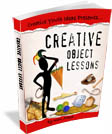Many a new Sunday School teacher has stood in front of a group of youth and experienced the stage fright that comes with being responsible for imparting spiritual knowledge to them. Teaching youth can be intimidating, to say the least. Some people seem to be born with the ability to connect with students, while others need a lot of tools to make the process go smoother.
Luckily, regardless of what category you would place your own teaching abilities into, object lessons are a tried and true strategy that can really turn a ho-hum lesson into a interactive experience with your youth. Most teachers recognize that there is a certain mood that is present when youth are engaged- a learning zen, if you will. Object lessons are one of the easiest ways to create this sort of learning environment. They were also frequently used in various forms by the greatest teacher of them all – Jesus.
In fact, the use of object lessons to teach spiritual truths traces back to the very beginning of Creation. God has not only consistently revealed himself through his creation, but God has used objects as metaphors for spiritual truths throughout the entire history of his communication with us. And contrary to their common use today with children and for children’s sermons, God and Christ both used them to teach adults. They are in fact very effective with children, youth and adults of all ages.
Understanding Object Lessons
Most people who have spent any time at all teaching understand the concept of object lessons. Instead of basing your entire lesson plan on lectures or pen and paper based activities, the effective teacher introduces the youth to the concept being discussed in a more tangible way. Object lessons are most often applied to difficult abstract concepts and spiritual truths.
The main thing that an object lesson does is create an emotional connection to the abstract concept, driving it home to the students under your influence. Instead of jumping right into a lesson plan, you pique the interest of the youth, unveiling an “aha” moment that gets brain cells engaged in the total learning process.
Object lessons do more than tell about what they are teaching. Instead, they show, in an easy to understand way, what it is that you are trying to portray. As mentioned previously, they are easily used in a teaching environment that involves children, but they are in fact more suitable for youth and adults that can discern and draw more powerful insights and connections. Furthermore, because older audiences have more biased viewpoints, object lessons are ideal for breaking through those barriers, which is a distinct advantage in any teaching situation. In order for students to grasp a concept, they must be open to it in the first place.
Why Use Object Lessons with youth?
As a teacher, preparation is always a part of the process. Teachers that are well prepared are able to reach their students in a much more profound way. Students realize that they are being made a priority and the learning is enriched. There are many other reasons to use object lessons are part of your teaching strategy with youth.
- Learning Retention: There is a teaching cliche that brings this concept into focus. When a student hears something, they may forget it; when they see something, they may retain it; when they experience something, it becomes a part of them, and learning becomes easy. Object lessons assist in the retention of learning, because more parts of the brain are engaged and the student experiences the lesson as a more wholly involved process.
- Simplifying Concepts: Especially when you are dealing with children and youth, there are a lot of times when you want to bring complex lessons down to a more understandable level. In order to do this, you have to create a connection between what is being presented and something that your student is already familiar with. Object lessons make this possible.
- Increased Involvement: Youth can become easily bored with the learning process. When you are able to get them up, moving, and involved, the synapses are activated and a more energetic class time is the result.
Overcoming Teaching Challenges
While object lessons almost always add value to youth lessons when properly placed in a lesson plan, they don’t always hit the mark, and there are few common reasons why.
- First, it can be extremely difficult to develop object lessons. While there are plenty of already developed plans, they may not directly relate to your specific curriculum used by your youth ministry or Sunday School. However, a good teacher can adapt an object lesson to their needs, as well as become adept at developing their own tangible representations of what is being presented.
- You also will want to carefully assess the impact that your object lesson is creating. While a properly designed demonstration will increase understanding and participation among youth, one that is placed in the wrong place, or doesn’t really apply can actually undo the potential good, creating more confusion and disconnect for your students. Keep a close eye on how your youth are reacting to the lesson that you selected and adjust it according to how effective you feel it was.
- In some instances, the presence of your demonstration can draw the attention of your students in such a way as it actually distracts from what you are teaching. This is more likely to occur if you are teaching young children. As a skilled teacher, be aware of this risk and be ready to counteract it in your class.
Finding Object Lessons Suitable for Youth
There are many places that you can look for object lessons:
- First, having several books with already developed lessons for youth on hand is a good idea. These are often developed for a certain demographic of students or for similar types of teaching situations. In fact, most of the books of object lessons on the market are geared towards children rather than youth and adults. However, they can be adapted by a skilled teacher to be used in many different situations.
- With teachers being classically inclined to share what works for them in the classroom, it is not at all uncommon to find compilations that other teachers have found to be useful in their own classrooms. Again, if your own teaching situation is fairly similar to the lessons being offered, you can apply them to your youth classroom almost verbatim. However, that is not always the case, and some adaptation may be necessary.
- Visit www.CreativeObjectLessons.com for almost 100 fully developed object lessons for youth and another 200+ started ideas.
As you can see, object lessons add a great deal of value to many different teaching situations. They provide a readily accessible way to reach students of all ages in a tangible way. They also allow students to become involved in the classroom environment and become engaged in the learning process. As a teacher, you can become skilled at using object lessons as a way to reach youth in a more useful way.


MORE IDEAS? See “Creative Object Lessons”
200 page e-book that explains everything you need to know when planning your very own object lessons. It contains 90 fully developed object lesson ideas and another 200 object lesson starter ideas based on Biblical idioms and Names / Descriptions of God.
Learn More…

 MORE IDEAS? See “Creative Object Lessons”
MORE IDEAS? See “Creative Object Lessons”

